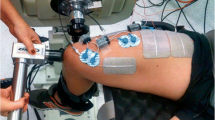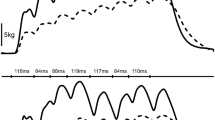Abstract
Purpose
The present study aimed at comparing knee extensor neuromuscular properties determined with transcutaneous electrical stimulation using two pulse durations before and after a standardized fatigue protocol.
Methods
In the first sub-study, 19 healthy participants (ten women and nine men; 28 ± 5 years) took part to two separate testing sessions involving the characterization of voluntary activation (twitch interpolation technique), muscle contractility (evoked forces by single and paired stimuli), and neuromuscular propagation (M-wave amplitude from vastus lateralis and vastus medialis muscles) obtained at supramaximal intensity with a pulse duration of either 0.2 or 1 ms. The procedures were identical in the second sub-study (N = 11), except that neuromuscular properties were also evaluated after a standardized fatiguing exercise. Electrical stimulation was delivered through large surface electrodes positioned over the quadriceps muscle and a visual analog scale was used to evaluate the discomfort to paired stimuli evoked at rest.
Results
There was no difference between pulse durations in the estimates of voluntary activation, neuromuscular propagation, and muscle contractility both in the non-fatigued and fatigued states. The discomfort associated with supramaximal paired electrical stimuli was also comparable between the two pulse durations.
Conclusions
It appears that 0.2- and 1-ms-long pulses provide a comparable evaluation of knee extensor neuromuscular properties.





Similar content being viewed by others
Abbreviations
- ANOVA:
-
Analysis of variance
- EMG:
-
Electromyographic
- Imax :
-
Maximal stimulation intensity
- MVC:
-
Maximal voluntary contraction
References
Aagaard P, Simonsen EB, Andersen JL, Magnusson P, Dyhre-Poulsen P (2002) Neural adaptation to resistance training: changes in evoked V-wave and H-reflex responses. J Appl Physiol 92(6):2309–2318. https://doi.org/10.1152/japplphysiol.01185.2001 (1985)
Aboodarda SJ, Copithorne DB, Power KE, Drinkwater E, Behm DG (2015) Elbow flexor fatigue modulates central excitability of the knee extensors. Appl Physiol Nutr Metab 40(9):924–930. https://doi.org/10.1139/apnm-2015-0088
Bampouras TM, Reeves ND, Baltzopoulos V, Jones DA, Maganaris CN (2012) Is maximum stimulation intensity required in the assessment of muscle activation capacity? J Electromyogr Kinesiol 22(6):873–877. https://doi.org/10.1016/j.jelekin.2012.02.018
Behrens M, Brown N, Bollinger R, Bubeck D, Mau-Moeller A, Weippert M, Zschorlich V, Bruhn S, Alt W (2016) Relationship between muscle volume and contractile properties of the human knee extensors. Appl Physiol Nutr Metab 41(1):110–113. https://doi.org/10.1139/apnm-2015-0378
Blimkie CJ, Sale DG, Bar-Or O (1990) Voluntary strength, evoked twitch contractile properties and motor unit activation of knee extensors in obese and non-obese adolescent males. Eur J Appl Physiol Occup Physiol 61(3–4):313–318
Bowman BR, Baker LL (1985) Effects of waveform parameters on comfort during transcutaneous neuromuscular electrical stimulation. Ann Biomed Eng 13(1):59–74
Buckthorpe M, Pain MT, Folland JP (2014) Central fatigue contributes to the greater reductions in explosive than maximal strength with high-intensity fatigue. Exp Physiol 99(7):964–973. https://doi.org/10.1113/expphysiol.2013.075614
Burke D (2002) Effects of activity on axonal excitability: implications for motor control studies. Adv Exp Med Biol 508:33–37
Burke D, Kiernan MC, Bostock H (2001) Excitability of human axons. Clin Neurophysiol 112(9):1575–1585
Delitto A, Strube MJ, Shulman AD, Minor SD (1992) A study of discomfort with electrical stimulation. Phys Ther 72(6):410–421 discussion on 421–414
Duchateau J (2009) Stimulation conditions can improve the validity of the interpolated twitch technique. J Appl Physiol (1985) 107(1):361. discussion 367–368
Gondin J, Guette M, Ballay Y, Martin A (2005) Electromyostimulation training effects on neural drive and muscle architecture. Med Sci Sports Exerc 37(8):1291–1299
Gorgey AS, Dudley GA (2008) The role of pulse duration and stimulation duration in maximizing the normalized torque during neuromuscular electrical stimulation. J Orthop Sports Phys Ther 38(8):508–516. https://doi.org/10.2519/jospt.2008.2734
Gracanin F, Trnkoczy A (1975) Optimal stimulus parameters for minimum pain in the chronic stimulation of innervated muscle. Arch Phys Med Rehabil 56(6):243–249
Gregory CM, Dixon W, Bickel CS (2007) Impact of varying pulse frequency and duration on muscle torque production and fatigue. Muscle Nerve 35(4):504–509. https://doi.org/10.1002/mus.20710
Johnson MA, Polgar J, Weightman D, Appleton D (1973) Data on the distribution of fibre types in thirty-six human muscles. An autopsy study. J Neurol Sci 18(1):111–129
Jubeau M, Rupp T, Temesi J, Perrey S, Wuyam B, Millet GY, Verges S (2017) Neuromuscular fatigue during prolonged exercise in hypoxia. Med Sci Sports Exerc 49(3):430–439. https://doi.org/10.1249/MSS.0000000000001118
Kennedy DS, McNeil CJ, Gandevia SC, Taylor JL (2016) Effects of fatigue on corticospinal excitability of the human knee extensors. Exp Physiol 101(12):1552–1564. https://doi.org/10.1113/EP085753
Klass M, Duchateau J, Rabec S, Meeusen R, Roelands B (2016) Noradrenaline reuptake inhibition impairs cortical output and limits endurance time. Med Sci Sports Exerc 48(6):1014–1023. https://doi.org/10.1249/MSS.0000000000000879
Knight CA, Kamen G (2005) Superficial motor units are larger than deeper motor units in human vastus lateralis muscle. Muscle Nerve 31(4):475–480. https://doi.org/10.1002/mus.20265
Lagerquist O, Collins DF (2008) Stimulus pulse-width influences H-reflex recruitment but not H(max)/M(max) ratio. Muscle Nerve 37(4):483–489. https://doi.org/10.1002/mus.20957
Levenez M, Kotzamanidis C, Carpentier A, Duchateau J (2005) Spinal reflexes and coactivation of ankle muscles during a submaximal fatiguing contraction. J Appl Physiol (1985) 99(3):1182–1188. https://doi.org/10.1152/japplphysiol.00284.2005
Liebano RE, Rodrigues TA, Murazawa MT, Ward AR (2013) The influence of stimulus phase duration on discomfort and electrically induced torque of quadriceps femoris. Braz J Phys Ther 17(5):479–486. https://doi.org/10.1590/S1413-35552012005000112
Miller M, Downham D, Lexell J (2003) Effects of superimposed electrical stimulation on perceived discomfort and torque increment size and variability. Muscle Nerve 27(1):90–98. https://doi.org/10.1002/mus.10289
Millet GY, Lepers R, Maffiuletti NA, Babault N, Martin V, Lattier G (2002) Alterations of neuromuscular function after an ultramarathon. J Appl Physiol (1985) 92(2):486–492. https://doi.org/10.1152/japplphysiol.00122.2001
Millet GY, Martin V, Martin A, Verges S (2011) Electrical stimulation for testing neuromuscular function: from sport to pathology. Eur J Appl Physiol 111(10):2489–2500. https://doi.org/10.1007/s00421-011-1996-y
Morat T, Gilmore KJ, Rice CL (2016) Neuromuscular function in different stages of sarcopenia. Exp Gerontol 81:28–36. https://doi.org/10.1016/j.exger.2016.04.014
Naaman SC, Stein RB, Thomas C (2000) Minimizing discomfort with surface neuromuscular stimulation. Neurorehabil Neural Repair 14(3):223–228. https://doi.org/10.1177/154596830001400308
Neyroud D, Vallotton A, Millet GY, Kayser B, Place N (2014) The effect of muscle fatigue on stimulus intensity requirements for central and peripheral fatigue quantification. Eur J Appl Physiol 114(1):205–215. https://doi.org/10.1007/s00421-013-2760-2
Neyroud D, Armand S, De Coulon G, Sarah RDDS., Maffiuletti NA, Kayser B, Place N (2017) Plantar flexor muscle weakness and fatigue in spastic cerebral palsy patients. Res Dev Disabil 61:66–76. https://doi.org/10.1016/j.ridd.2016.12.015
Place N, Lepers R, Deley G, Millet GY (2004) Time course of neuromuscular alterations during a prolonged running exercise. Med Sci Sports Exerc 36(8):1347–1356
Place N, Maffiuletti NA, Martin A, Lepers R (2007) Assessment of the reliability of central and peripheral fatigue after sustained maximal voluntary contraction of the quadriceps muscle. Muscle Nerve 35(4):486–495. https://doi.org/10.1002/mus.20714
Place N, Casartelli N, Glatthorn JF, Maffiuletti NA (2010) Comparison of quadriceps inactivation between nerve and muscle stimulation. Muscle Nerve 42(6):894–900. https://doi.org/10.1002/mus.21776
Rodriguez-Falces J, Maffiuletti NA, Place N (2013) Spatial distribution of motor units recruited during electrical stimulation of the quadriceps muscle versus the femoral nerve. Muscle Nerve 48(5):752–761. https://doi.org/10.1002/mus.23811
Rozand V, Grosprêtre S, Stapley PJ, Lepers R (2015) Assessment of neuromuscular function using percutaneous electrical nerve stimulation. J Vis Exp (103):e52974. https://doi.org/10.3791/52974
Saugy J, Place N, Millet GY, Degache F, Schena F, Millet GP (2013) Alterations of neuromuscular function after the world’s most challenging mountain ultra-marathon. PLoS One 8(6):e65596. https://doi.org/10.1371/journal.pone.0065596
Scott WB, Causey JB, Marshall TL (2009) Comparison of maximum tolerated muscle torques produced by 2 pulse durations. Phys Ther 89(8):851–857. https://doi.org/10.2522/ptj.20080151
Scott W, Flora K, Kitchin BJ, Sitarski AM, Vance JB (2014) Neuromuscular electrical stimulation pulse duration and maximum tolerated muscle torque. Physiother Theory Pract 30(4):276–281. https://doi.org/10.3109/09593985.2013.868563
Simoneau E, Martin A, Van Hoecke J (2005) Muscular performances at the ankle joint in young and elderly men. J Gerontol A Biol Sci Med Sci 60(4):439–447
Staehli S, Glatthorn JF, Casartelli N, Maffiuletti NA (2010) Test-retest reliability of quadriceps muscle function outcomes in patients with knee osteoarthritis. J Electromyogr Kinesiol 20(6):1058–1065. https://doi.org/10.1016/j.jelekin.2010.07.006
Stevens-Lapsley JE, Balter JE, Wolfe P, Eckhoff DG, Schwartz RS, Schenkman M, Kohrt WM (2012) Relationship between intensity of quadriceps muscle neuromuscular electrical stimulation and strength recovery after total knee arthroplasty. Phys Ther 92(9):1187–1196. https://doi.org/10.2522/ptj.20110479
Strojnik V, Komi PV (1998) Neuromuscular fatigue after maximal stretch-shortening cycle exercise. J Appl Physiol (1985) 84(1):344–350
Vagg R, Mogyoros I, Kiernan MC, Burke D (1998) Activity-dependent hyperpolarization of human motor axons produced by natural activity. J Physiol 507(Pt 3):919–925
Ward AR (2014) Electro-muscle stimulation therapy. Comprehensive biomedical physics, 10. Elsevier, Netherlands, pp 231–253
Author information
Authors and Affiliations
Corresponding author
Ethics declarations
Conflict of interest
The authors declare that they have no conflict of interest.
Ethical approval
All procedures performed in studies involving human participants were in accordance with the ethical standards of the institutional and/or national research committee and with the 1964 Helsinki declaration and its later amendments or comparable ethical standards. This article does not contain any studies with animals performed by any of the authors.
Informed consent
Informed consent was obtained from all individual participants included in the study.
Additional information
Communicated by Olivier Seynnes.
Rights and permissions
About this article
Cite this article
Giroux, C., Roduit, B., Rodriguez-Falces, J. et al. Short vs. long pulses for testing knee extensor neuromuscular properties: does it matter?. Eur J Appl Physiol 118, 361–369 (2018). https://doi.org/10.1007/s00421-017-3778-7
Received:
Accepted:
Published:
Issue Date:
DOI: https://doi.org/10.1007/s00421-017-3778-7




